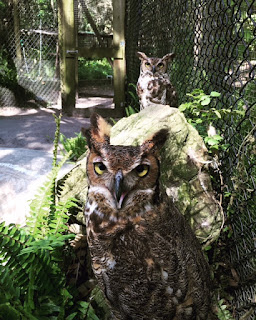Location: Moccasin Lake Park
Date: August 26, 2016
Weather: Around 90º, hot and a bit humid
Moccasin Lake Park is a 51-acre nature preserve comprised of
trails, boardwalks, ponds, creeks, and a dock on the lake.
When we began our day learning that we would be clearing out
caesar weed and air potatoes I was less than enthusiastic; pulling weeds didn’t
sound very educational. I’m glad to say I was wrong. During the hour or so that
we worked I was truly able to see just how “invasive” these species of plants
were and how in the areas that we cleared there was very little of any other
vegetation. These plants blanketed the ground as far as the eye could see,
taking over the area and pushing out all other plant life. It made me wonder
about invasive plants and insects that may affect the world’s agriculture.

Throughout the park we could constantly hear crickets and
often found spiders and other related insects from the Arthropod phyla, as well
as the occasional earthworm from the Annelida phyla. We also encountered many
classes from the Chordata phyla within the park’s animal sanctuary area, such
as vultures, owls, and hawks (Avian Reptilian), frogs, toads, and salamanders
(Amphibian), turtles and snakes (Non-Avian Reptilian), and at the lake I am
fairly certain a few of us caught a glimpse of a catfish (Osteichthyes).

It was fairly easy to see a separation in the plant life at
different elevations with even a slight change. Although native ecosystems are
self-sustaining when left alone, some areas, mainly at the beginning of the
trail, displayed evidence of Secondary Succession. On one side of the trail
there was a full canopy of the trees and a lot of vegetation, while on the
opposite side the canopy was sparse resulting in less vegetation being present
on the ground. Often we passed tall pines (Coniferophyta) and cabbage palms
(Moilophyta), a highly adaptable plant. We also came across specimens from the
Fungi Kingdom. The shelf fungus (Ascomycota) was especially interesting to see
as I don’t often encounter it. The lichen, on the other hand, I was surprised to
learn was not only a fungi but also an algae.

Over all I would have to say that the most fascinating part
of this outing was my experience with the Mimosa Pudica (Anthophyta or Magnoliophyta).
This plant, the “Touch Me Not,” utterly amazed me when it folded its leaves to
protect itself when it registered the electrical impulses from my fingertips. I
am sincerely looking forward to more day-trips similar to Moccasin Lake Park.




















